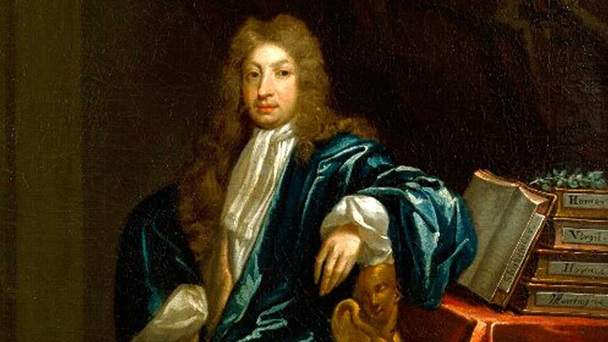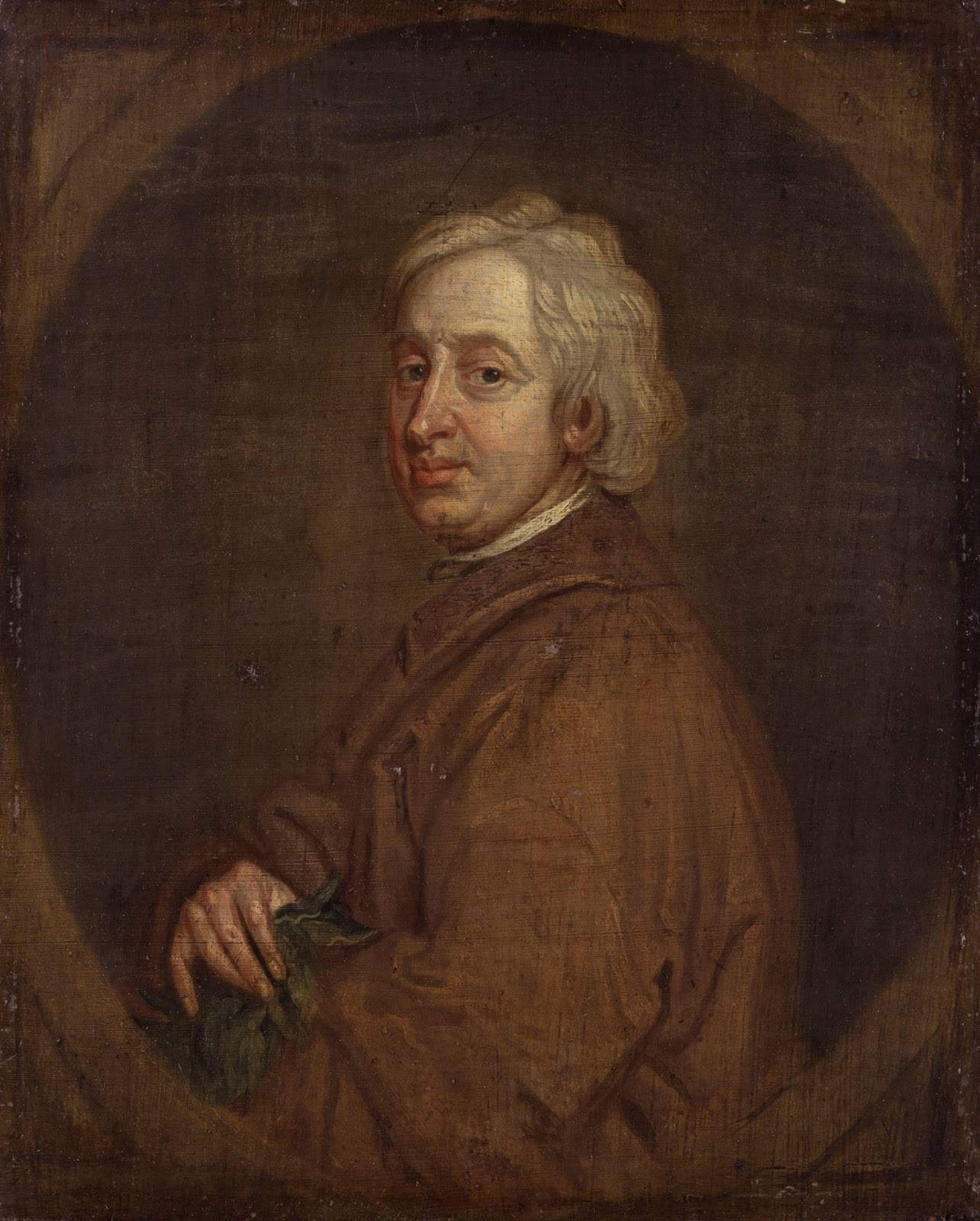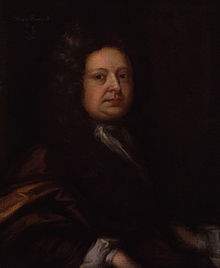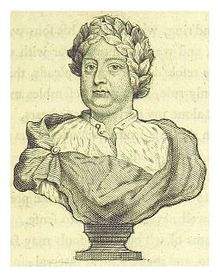John Dryden
Authorial Context: John Dryden (1631–1700)
The English poet John Dryden was born in Northamptonshire in 1631 as the oldest of 14 children. When Dryden was still a teenager, the English Civil War (1642–1651) broke out, bitterly dividing the country. Although his family was Puritan and Parliamentarian, Dryden was mainly educated by a Royalist. At 18 years old, Dryden rebelled against his family by publishing a poem with Royalist sympathies. He did not publish another significant work until after he had attended and graduated from Trinity College in Cambridge.
Although he had seemed anti-Commonwealth before, the young man went on to work within Oliver Cromwell's government until Cromwell died in 1658. He even wrote Heroic Stanzas (1658) to eulogize Cromwell.
Then, once the Restoration of the monarchy occurred, Dryden wrote several panegyrics (texts in praise of someone) for the king and the Lord Chancellor. No one is sure whether Dryden's ideas kept changing or if he was just a cunning sympathizer.

Following his marriage to Lady Elizabeth Howard in 1663, Dryden began writing plays to help support his family. He started with comedy—The Wild Gallant, Marriage à la Mode—and moved on to dramatic tragedies, such as Aureng-zebe, All for Love, and The Conquest of Granada.
But Dryden is also well-known for his satirical poetry in the 1680s: Mac Flecknoe, The Medal, and Absolam and Achitophel. Absolam and Achitophel is not a mock epic, like Mac Flecknoe, but a somber allegory of King Charles II and the Exclusion Crisis, in which Charles II tried to exclude his brother from the throne because he was a Roman Catholic. In his prologue to the poem, Dryden lays out the definition of satire as we know it today, writing that "the true end of satire is the amendment of vices by correction."
In his later years, the accomplished Neoclassical poet published many translations of the classical writings by Virgil, Horace, Ovid, Lucretius, and more. He died in May of 1700 and was buried in the "Poet's Corner" in Westminster Abbey.
Dryden's Legacy
Dryden was named England's first Poet Laureate by Charles II in 1668, a highly honorary position. But his influence would prove to be far more long-lasting and widespread than he could have known.
He excelled in all literary forms: poetry, plays, essays, and translations. He set the standards and conventions for Neoclassical literature, such as the universal use of the heroic couplet, poetic satire in the English language, and the mock-epic genre. Later Neoclassical poets Jonathan Swift and Alexander Pope would become more popular for their satire and mock-epic poetry, but both took their cues from Dryden.
Dryden's rational, frank style reflects the spirit of his age (the Age of Enlightenment) and sets him apart from most of the poetry in the following centuries.

After John Donne and John Milton, John Dryden was the greatest English poet of the seventeenth century. After William Shakespeare and Ben Jonson, he was the greatest playwright. And he has no peer as a writer of prose, especially literary criticism, and as a translator.
Poetry Foundation
Mac Flecknoe (1682)
Poem Context
Dryden wrote Mac Flecknoe about one of his contemporaries, the poet and playwright Thomas Shadwell. Although the two used to be good friends, after many years of arguments over literature and politics, Dryden decided to write what he really thought about Shadwell's writing. In this mock-epic poem, Dryden sarcastically hails his contemporary as the king over the "realm of Nonsense." Every line is essentially one vicious burn after another.

This is also one of the earliest examples of the mock epic in the English language, a genre that would become the staple of the Neoclassical period.
Mock epic: "treats the low, mean, or absurd in the grand language, lofty style, and solemn tone of epic poetry. The obvious disparity between subject and style makes the satiric point"
- The Norton Anthology of English Literature
We will see lots of Neoclassical elements in Mac Flecknoe. First, the poem is composed entirely of heroic couplets (pairs of rhyming lines in iambic pentameter). It also borrows from classical genres of epic poetry and Horatian satire (named after the Roman satirist Horace). There will be countless allusions to Greco-Roman myths and figures.
11:19
Embedded here is an audio performance of the poem. To help with comprehension, listen along as you read or before/after you read.
As you read, hover your mouse over the blue lines to get extra explanations of confusing terms or allusions.
Mac Flecknoe
Poem Highlights
Literary Device
Allusions
In Mac Flecknoe, Dryden layers one insult on top of another, but he does it in a very well-read, classy way. If you paid attention to the annotations, you saw how often he refers to (alludes to) ancient myths, the Bible, Paradise Lost, and even current events. This is a Neoclassical convention: Neoclassical poets incorporated both classical literature and the politics of the day in their writing.
Form
Heroic Couplets
Heroic couplets are pairs of rhyming iambic pentameter lines. Although Chaucer was the first to use this form in the English language, Dryden popularized and perfected it in the 17th century.
Heroic couplets reflect the orderliness and wit of the Neoclassical era. The meter is even and consistent, and the rhyming pairs allow for a lot of sharp humor.
There thou may'st wings display and altars raise,
And torture one poor word ten thousand ways.Did you enjoy this form of poetry? Do you find it easier or harder to understand?
Genre
Mock-Epic Elements
There are many ways we can tell that Mac Flecknoe is a mock epic.
Flecknoe (who was also a real poet) and Shadwell are "mock heroes." They are the opposite of strong, brave heroes like Odysseus or Hector: "dullness" and "stupidity" are their signature traits. In lines 121–129, Dryden paints a silly image of Shadwell as a hero-king, with a mug of ale and Flecknoe's terrible play in his hands instead of a ball and scepter. Shadwell also wears a crown of poppies to symbolize his dreariness.
Dryden sarcastically uses the lofty language and style of epics when describing Shadwell's lame writing: "Thy Tragic Muse gives smiles, thy Comic sleep. / With whate'er gall thou sett'st thy self to write, / Thy inoffensive satires never bite."
To point out the long history of bad writing, Dryden uses the classical imagery of kings and prophets.
Heywood and Shirley were but types of thee,
Thou last great prophet of tautology:
Even I, a dunce of more renown than they,
Was sent before but to prepare thy way. (lines 29–32)
Dryden takes the genre, conventions, and imagery that his readers would have been very familiar with and turns them on their heads.

Style
Satire
Mac Flecknoe is essentially a 17th-century roast! Dryden's satire is not subtle at all. But is he just mocking Shadwell? Or is he trying to do some good?
Remember, good satire uses humor and exaggeration to reveal folly. In Mac Flecknoe, Dryden points out two foolish/immoral things:
Bad writing (Flecknoe's, Shadwell's, Heywood's, Shirley's ...). He takes offense at writing that is boring and safe, as well as poems that "torture one poor word ten thousand ways" (line 208).
The reading public. We will dwell on this more in today's lesson review.